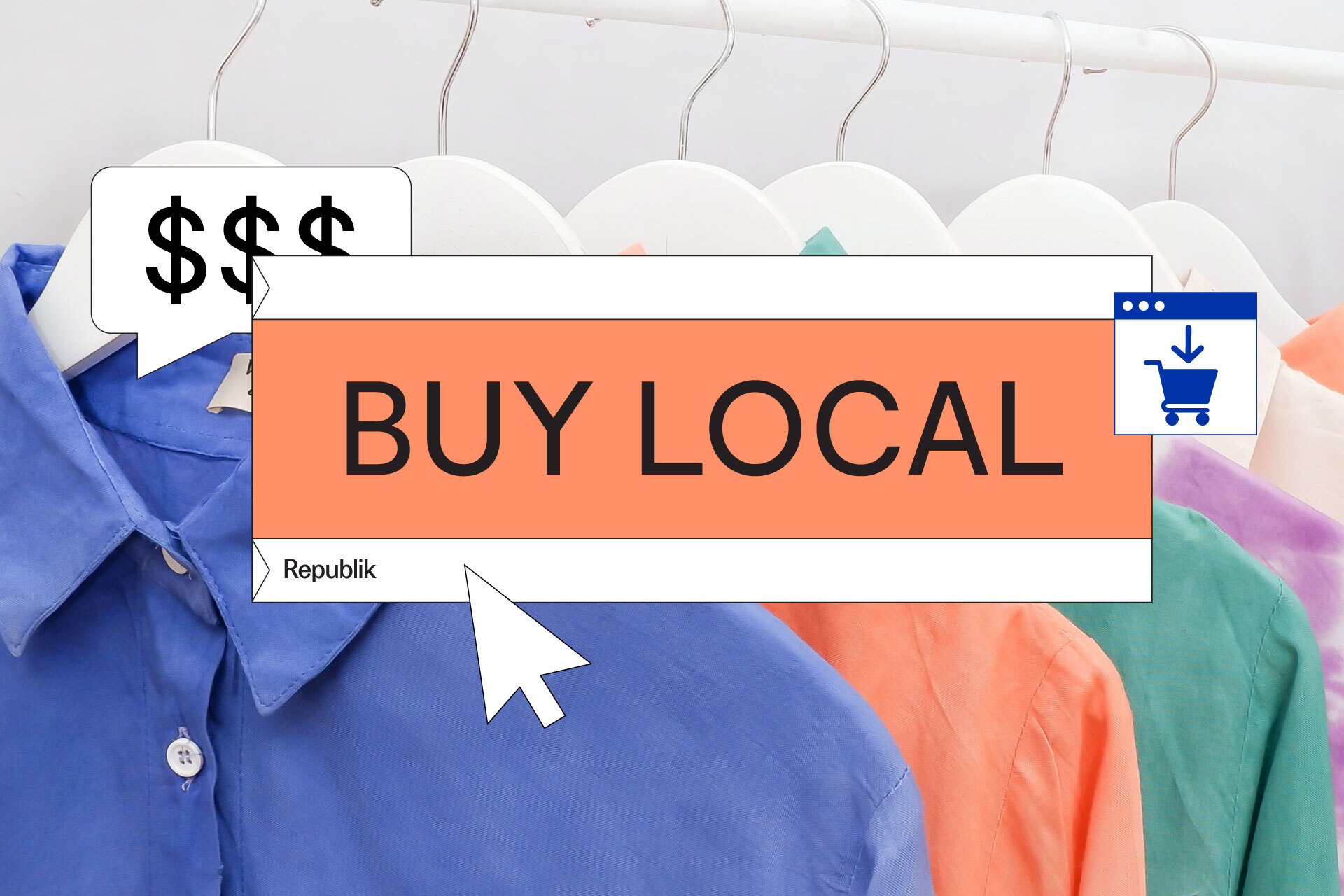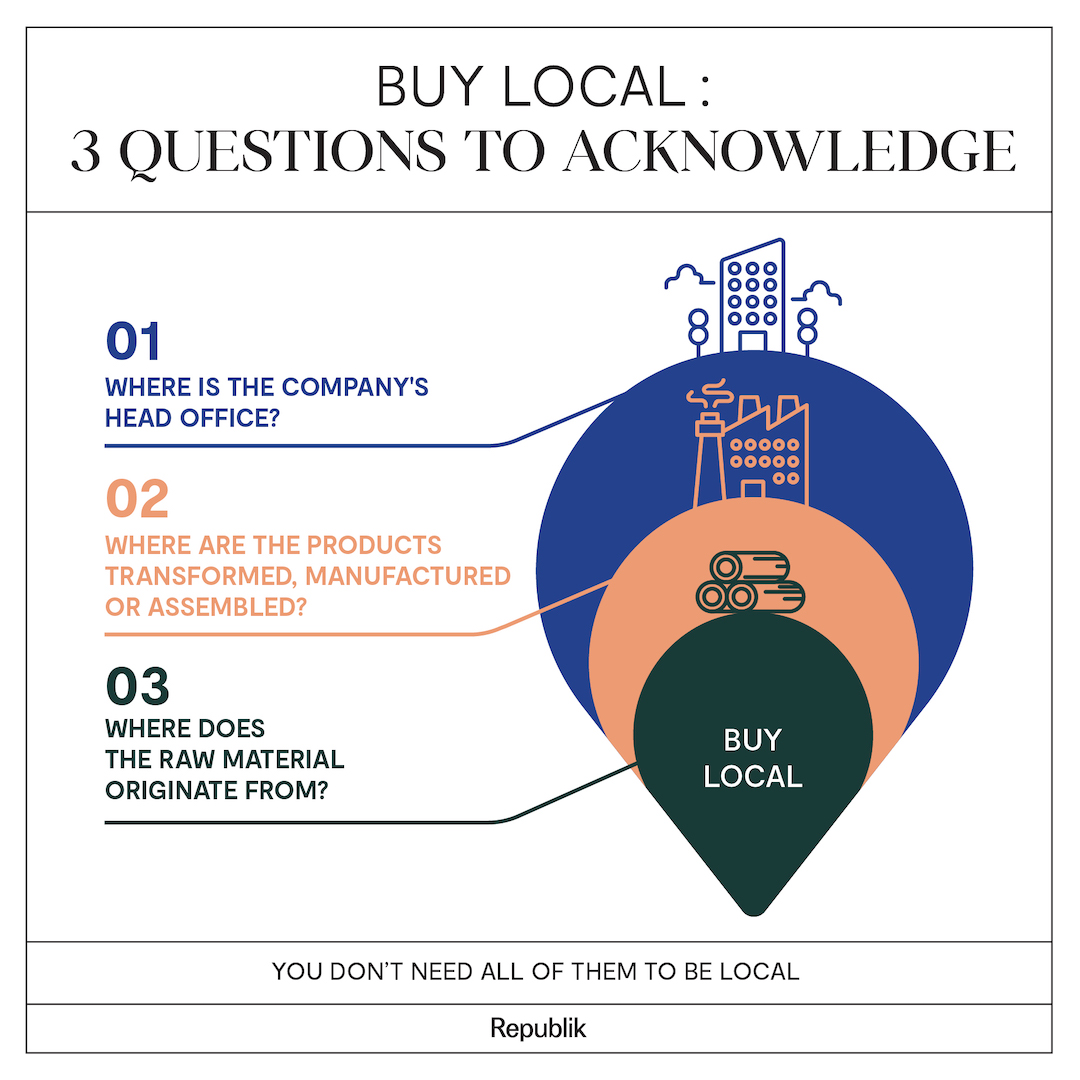
Purplewashing: what is it and how to avoid it?

Investing in what's made here is an effective way to support our community at all times. But how do we incorporate it into our daily shopping? With this question in mind, there is certainly a need to define, and even expand, the criteria to consider when making our purchasing decisions.
When we think of buying local, we naturally turn to our craftsmen and small local boutiques. But let's also promote awareness to the contribution of more prominent local brands. One does not exclude the other, and by informing ourselves more, we have the power to create our wealth and diminish the repercussions.
"Buying local is to purchase from companies from here. Big or small. Buying local is also employing people from here. It is to protect jobs and families."
We must stress that local buy does not always mean a sustainable economy. Social and environmental aspects linked to the sustainable economy are complex and non-exclusive to local purchases, even if it is a considerable part of it. Inversely, "delocalized" buys are not necessarily "unsustainable".
The idea is not to depreciate the numerous sustainable foreign brands (many are indeed worth mentioning), but more to elevate the ones near to us.
Here are 3 questions you should ask yourself before making your next purchase, and examples for the industries of restaurants, grocery shopping, fashion and e-commerce.

1 - Where is the company's head office?
Which means, does this company, even during those dark times, generate jobs in my area/province/country? Any business that sells its products in Canada necessarily creates customer service jobs. But does it create jobs with added value? Depending on the industry, those jobs usually come with executives' activities, conception and innovation, packaging, storage and delivery.
2 - Where are the products transformed, manufactured or assembled?
Which means, do these companies mobilize our workforce within one or another step of the transformation? The more steps there are to the value chain located in Quebec or Canada, the more this business is seen as local.
3 - Where does the raw material in order to make that product originate from?
Caution, it usually at that moment that we experience a breaking point from all the buy-local purists. Raw materials is key, but it’s not everything.
Let's take a few examples from everyday life and apply the three primary considerations to the restaurant, food and online shopping industry.
It’s a no-lunch day. You feel like ordering a lunch to-go and are hesitant between Subway, St-Hubert and Starbucks.
St-Hubert: is a Canadian business that operates via a franchise system. Therefore, the totality of its profit is invested locally. When you're ordering your rotisserie chicken-breast from St-Jérôme, it is not only the owner of the franchise and its employees that you are supporting but also the whole food industry (chicken, beef, bread producers). When you're ordering from St-Hubert, you are without a doubt supporting the local economy. In the same vein, Copper Branch, Pizzeria 900, Ashton, Mandy’s, Van Houtte.
It's a yes for St-Hubert!
Subway: is an American business. But let's bring a certain nuance. It operates via franchises, where part of the establishment income will be reinvested in the local economy. Subway also puts an effort supplying certain ingredients via local businesses (like 100% Canadian beef and ham).
Subway is good, but there are better options!
Starbucks: is an American company that operates via corporate establishments, not via a franchise system. The business profits are then not reinvested locally. The supplies (eggs, as an example) and transformation (coffee roasting, per se) also are mostly delocalized, in that exact case in the US. But let's also mention that the company makes significant efforts in selecting the right suppliers and offers high working conditions to their employees operating within their supply chain, which brings the nuance between sustainable and local.
Sorry Starbucks, but it's a no for us!
The refrigerated counter where we can find fresh juices in grocery stores is always full. A lot of local brands, but also foreign ones, are competing against each other. Let's take Tropicana, LOOP and Oasis as an example.
LOOP: is a Canadian company (located in Anjou) that transforms its products in Quebec, and that, above all, uses ingredients that occurred to be garbage-condemned. Fancying LOOP is not only an excellent local-oriented choice but also an environment one that limits food waste. In the same vein comes Oatbox, Evive, 1642, St-Viateur Bagel, GURU, Laitues Mirabel , all microbreweries in Quebec, The Unscented Company and Pur Vodka that all fill the local-buy criteria.
LOOP is one hard to beat company!
Oasis: is a Canadian business (Lassonde) that transforms its products in Rougemont, Quebec. Lassonde employs thousands of people in Quebec and uses local products, like our Apples, in between its supply chain. Admittedly, like its competitors, their oranges from their juices are not locally produced (and could hardly be so). Oasis is a good example of a brand that, even if it issues from a big corporation, cuts for local buy. Purchasing Lassonde products is reinvesting your dollars into our economy. In the same vein: Bonduelle, Agropur, Saputo, Chocolats Favoris, Olymel, Maison Orphée, Nutrinor and Ménard.
It's a yes for Oasis!
Tropicana: is an American company (PepsiCo) that transforms its products and supply itself in the United-States only. In the actual economic context, Tropicana is a hard choice to justify. In the same vein, Minute Maid, Pepsi, Coke and FritoLay.
It's a no for Tropicana!
You decide to order one of your favourite products online. The product, locally-made or not, is available on many platforms. Which one should you opt for?
Amazon: is an American business mostly used to showcase products to an international audience. Then, in order to validate the local aspect of the transaction, you would have to analyze many factors. In most cases, if you're looking for a precise item, let's say a winter coat, you'd have to recognize that the localization of the seller is hard to decipher. Then you'll have to investigate the article itself, the brand, its location, place of fabrication and the origin of its raw material. The answers to the three essential questions are quite hard to find and mostly very unsatisfying. In the same vein, eBay, Walmart.
Sorry Amazon!
Altitude Sports: is a Canadian company that stores available items on its transactional site in Montreal. Given the specific wanted product, you would have to do the same research as on Amazon. However, in that case, you're making sure that the intermediate between you and the manufacturer is Canadian and contributes to the local economy. To help you make a wiser choice, note that Altitude Sports presents a wide selection of Canadian brands via its Made in Canada section. In the same vein, Etsy Made in Québec, Bonlook, Rubino Shoes, DeSerres and Simons.
Yes, to Altitude Sports, and use this opportunity to buy products from here!
Signé Local: is a Canadian company that put together a web repertoire regrouping more than 450 creators offering locally made, produced and packaged products. The three essential questions are positive, and even more! In the same vein: Idée Cadeau Québec, Golf Avenue and LesPAC.
Signé Local website is a big yes!
You decide to order one of your favourite products online. The product, locally-made or not, is available on many platforms. Which one should you opt for?
H&M: is a Swedish company. Its accessories and clothing are fabricated all over the globe, especially China, India, Bangladesh, Angora, but never Canada. The raw materials, which rarely come from Canada in that whole category, also come from developing countries. We could think of many other instances that will convince you not to buy H&M (aside from the price). For the benefit of this article, we will limit ourselves to the fact that your dollar at H&M doesn't do much for our economy. Similarly, Zara and Urban Outfitters.
It's a big no for H&M!
Frank&Oak: is a Canadian business. F&O does not manufacture its clothing here. However, your invested dollars are helping many individuals, since their head office is located in Montreal, on Saint-Viateur. They additionally own 21 boutiques across Canada. Note that Frank & Oak took a green shift in the last few years, transforming the company into a B-Corp business. Their manufacturing, fabrication and procurement of raw materials took a better turn for the planet. When you are buying F&O, you are supporting a local company, but also not promoting fast fashion. In the same vein, Peppermint, Vallier, Aldo, Dynamite, Garage.
Yes to Frank and Oak!
Audvik: is a Canadian business that manufactures its clothing in Montreal from imported fabrics. The company offers many options made of recycled materials. Purchasing from them is a great way to help the local economy and the environment. So, why not? In the same vein: Kanuk, Quartz, NIL, Gibou, C’est Beau, Tristan, La Petite Garçonne.
It's a yes for Audvik, and start by checking out their newest collection made of recycled material!
The three basic considerations (location, place of fabrication and origin or raw materials) will help guide you towards local-friendly choices.
We are encouraging you to keep them in mind for your next purchase, but also remember that nothing is perfect and that you can pair them with a good common sense.
For example, certain raw materials like oranges or coffee grains cannot be found in their natural forms in Canada. The solution is not to eliminate all consumption of orange juice or coffee, but to turn to local businesses that transform or sell these products locally.
Putting into perspective those alternatives in order to make a conscious decision is always a big step! If you are hesitating, acknowledge that the Internet overflows with useful tips that will guide you through your consumption. If you need a helping hand, contact us!
Go ahead! Buy local! Invest in your economy!
The vast majority of our consumer products, all industries combined, have a local alternative. Let's use our purchasing power to ask ourselves the right questions.